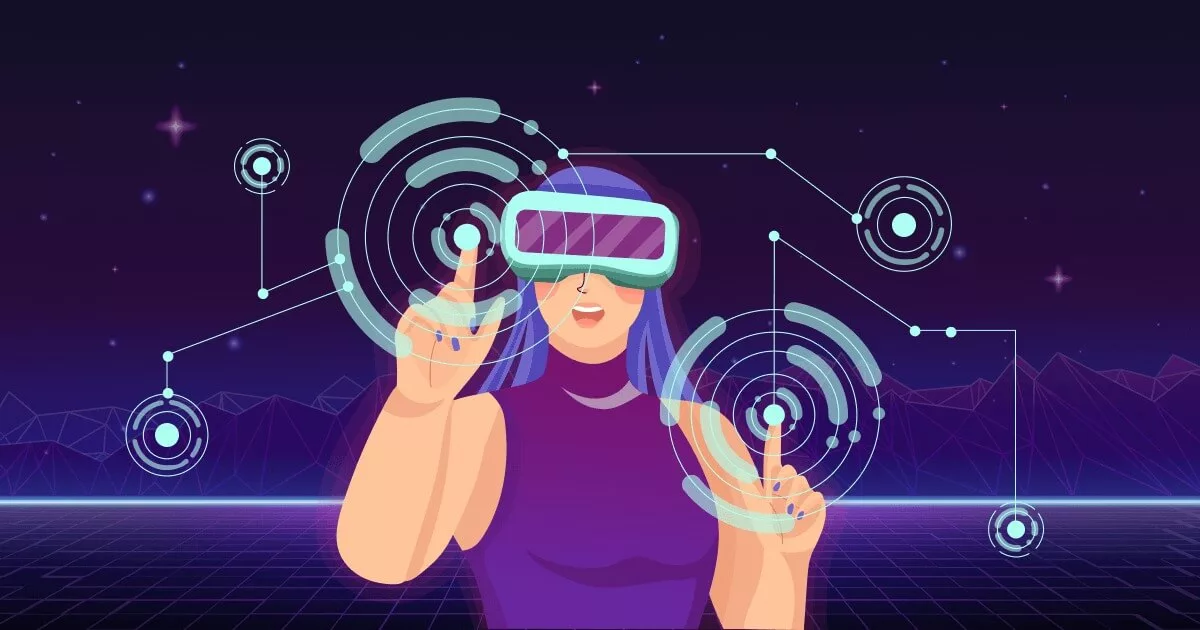
The concept of the Metaverse has captured the imagination of people worldwide. Many see a future where virtual environments become a primary venue for work, socializing, entertainment, and even education. This vision of a virtual universe was vividly brought to life in the popular science fiction novel and movie “Ready Player One,” where a vast metaverse known as the OASIS is a central hub for human interaction and business. You might think that’s the only form of the metaverse to exist, but let us surprise you. There are several types of metaverse, each with unique use cases. Let’s dig into these types and discuss their potential impact on our daily lives.
What Is a Metaverse?
Metaverse is a virtual universe that combines elements of video games, social media, and online communities to create an immersive and interactive experience. In the Metaverse, you can create a digital version of yourself, known as an ‘avatar.’ You can use it to explore various virtual worlds and interact with other users.
The concept of Metaverse has been around for decades. Neal Stephenson coined the term “Metaverse” in his novel “Snow Crash” in 1992 to describe a 3D virtual space. It was imagined as a virtual world where individuals could escape from reality and create unique digital personas.
It has recently gained renewed attention thanks to technological advancements like virtual reality (VR) and augmented reality (AR).
One of the most exciting things about the Metaverse is it’s constantly evolving. As technology grows, so do the possibilities for what can be done in the Metaverse. It’s a place where imagination knows no bounds and anything is possible.
So, whether you’re looking to escape reality for a while, connect with people from all over the world, or simply explore new and exciting digital environments, the Metaverse has something for everyone.
Types of Metaverse
There are broadly four types of metaverse based on gaming, social, commerce, and education.
1. Gaming-based metaverse
A gaming-based metaverse is a virtual universe that mainly focuses on gaming and interactive entertainment experiences.
This type of metaverse revolve around gaming mechanics, allowing users to engage in gameplay, quests, and other challenges while exploring virtual worlds.
An interesting real-world example of a gaming-based metaverse is ‘Roblox.’
Roblox is a multiplayer online game that allows users to create their own games and play games created by other users. This platform has become a sensation due to its vast collection of user-generated content, including various games, virtual experiences, and social spaces.
Also, users can buy virtual goods and other in-game items using Roblox’s virtual currency, ‘Robux.’
2. Social-based metaverse
A social-based metaverse enables social interaction, communication, and collaboration. These metaverses facilitate social connections, allowing users to meet new people and connect with friends and family.
One example of this type of metaverse is ‘Second Life.’
Second Life is a virtual world that allows users to create avatars and interact with other users in various virtual environments. The platform is designed to be a social hub with a wide range of activities and events to foster social connections and community building.
Second Life is unique in allowing users to create and customize their virtual spaces, providing a sense of ownership and creative control.
3. Commerce-based metaverse
A commerce-based metaverse, as the name suggests, facilitates commerce. It allows users to buy and sell virtual goods and services within a virtual environment.
It provides a virtual marketplace for users to conduct business and handle e-commerce transactions.
Decentraland is a well-known commerce-based metaverse. It is a virtual world on top of blockchain that allows users to create, experience, and monetize content and applications. The platform uses a cryptocurrency called ‘MANA’ as its native token. It lets users buy and sell goods and services.
Also, users can buy and sell virtual land within the platform, creating a dynamic marketplace for virtual real estate.
4. Education-based metaverse
An education-based metaverse enhances educational experiences and opportunities for users.
It provides a virtual environment for students to attend classes, engage in group projects, and interact with instructors and other learners.
One example of an education-based metaverse is ‘Engage.’
Engage is a virtual reality platform providing various educational experiences, including virtual field trips, training simulations, and online courses. The platform is designed to be a collaborative learning environment, allowing users to interact with course content in various ways.
Engage has been particularly valuable during the COVID-19 pandemic, as it has allowed schools and universities to continue providing educational opportunities to students without the need for in-person classes.
How does a Metaverse Work?
A metaverse is a virtual world within a computer network, typically the internet. It consists of interconnected virtual environments, each with its own unique characteristics and properties.
The metaverse is designed to be a shared, persistent space. It means it can be simultaneously accessed by multiple users from different locations and times.
To access a metaverse, users typically need an internet-connected device capable of running software compatible with the metaverse platform. This software, often called a client or viewer, allows users to create an avatar and navigate the virtual environment.
The technology behind a metaverse can be complicated. It often involves a combination of software, hardware, and networking technologies. Metaverses may use a variety of programming languages — C++ or JavaScript. They may rely on complex algorithms and data structures to manage the virtual environment.
How to Access a Metaverse?
There are several different ways to access a metaverse.
1. Virtual reality headsets
One of the best ways to access a metaverse is through virtual reality (VR) headsets, such as the Oculus Rift, HTC Vive, or PlayStation VR. These devices allow users to fully immerse themselves in a virtual environment and interact with other users and virtual objects.
2. Desktop or mobile apps
Many metaverses also offer desktop or mobile apps. These apps often provide a less immersive experience than VR. But, they allow users to interact with others and participate in virtual environments.
3. Web-based platforms
Some metaverses can be accessed directly through a web browser, such as Second Life and Twinity. These platforms typically offer a less immersive experience than VR headsets or desktop apps.
4. Social media
Some social media platforms, such as Facebook and Instagram, are also beginning to integrate metaverse-like features into their platforms.
5. Game consoles
Some metaverses can be accessed through game consoles, such as the PlayStation and Xbox. These consoles typically require a compatible game and may offer a more limited metaverse experience compared to other methods of access.
The Future of Metaverse
The future of the metaverse is a topic of much debate and speculation.
But one thing is clear: there is a growing interest in developing different types of metaverse.
As technology advances and becomes more accessible, metaverses will likely become more immersive, interactive, and integrated into our daily lives.
Some experts predict that the metaverse will become a fully-realized version of the internet. Users can seamlessly move between virtual environments and experiences, much like we navigate between websites today.
Others envision a future where the metaverse becomes a primary venue for work, socializing, entertainment, and even education.
One potential impact of the metaverse is that it could change how we think about physical space and the concept of “place.” It may become more common for people to experience events, socialize, and conduct business within the metaverse, blurring the lines between the physical and virtual worlds.
Another potential impact of the metaverse is that it can democratize access to information and resources. This could significantly affect education, commerce, and social and political engagement.
All these factors makes metaverse a feasible option for a long-term investing , learn on different ways of investing in metaverse
Conclusion
The development of metaverses represents a fascinating convergence of technology and human imagination.
As we have explored, there are several types of the metaverse, each with unique features and applications.
As the technology and infrastructure of metaverses continue to evolve, we will likely see new types of metaverse emerge. It will be fascinating to see how these virtual universes develop and how they are used by people worldwide.
FAQs
1. What is the difference between a metaverse and a virtual world?
A metaverse is a network of interconnected virtual worlds. In contrast, a virtual world is a self-contained digital environment.
A metaverse allows users to move between different virtual environments and experiences seamlessly. A virtual world typically focuses on a single theme or purpose, such as gaming or socializing.
2. What is the role of blockchain in a metaverse?
Blockchain technology can play an essential role in a metaverse. It enables secure and transparent transactions of virtual assets, such as virtual currencies and digital goods.
It can also establish trust and ownership of digital assets and enable decentralized governance of metaverse environments.
3. What are the benefits of using a metaverse?
Using a metaverse offers several benefits.
- It allows users to connect with others worldwide
- It offers access to new and innovative virtual experiences
- It enables new forms of commerce and education
Metaverses can also offer opportunities for personal and professional growth. It is a way to experiment with different aspects of creativity in a safe and supportive environment.





